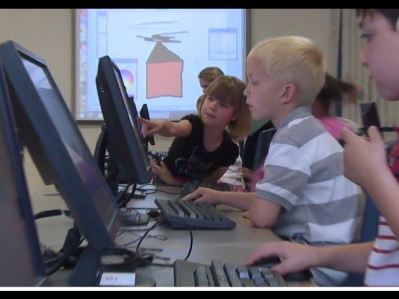Building the Learning Environment: Educational Technology
Update December 2020:
This web page is a companion to the 2016 version of the School Library Program Rubric. NYSED released an updated School Library Program Rubric in December 2020.
Student Snapshot: Technologies to impact student achievement are integrated into teaching and learning through the library media program.
Bendit et. al states (2010) all students will access learning materials in electronic form, including video, text, and other digital content related to the school curriculum. Students will create work, define and solve problems, and research and evaluate information using technology. Our students will develop innovative approaches to communicate and collaborate. Multiple environments will exist for teaching and learning, unbound by place, time, income, language or disability. Students will access learning resources anywhere, anytime through the use of technology.
Source: Bendit, Charles R., Joseph E. Bowman, Jr., and Harry Phillips. “USNY Statewide Learning Technology Plan”. New York State Education Department.
Citation for Photo: Photo of kindergarten library class in East Moriches, NY; used with permission from EngageNY.org
In Practice
The Changing Role of School Librarians
Description: Mark Ray contrasts librarians’ past roles as simply handling books with the new role of teacher-librarians who focus on information acquisition in books and online. The video includes footage of lessons with elementary school students, and discussion of the needs of students who have not been exposed to technology.
Resource/Citation: The Changing Role of School Librarians. Perf. Mark Ray and Shana Ferguson. YouTube. Vancouver (WA) Public Schools, 8 Mar. 2013.
Teaching Beyond the Library
Description: Librarian Traci Chun emphasizes the importance of teaching in the classroom as well as in the library; she describes how she introduces students to new iPads in their classroom. She describes her role as a leader who can introduce teachers to new technology.
Resource/Citation: “Teaching Beyond the Library”. YouTube, uploaded by Vancouver Public Schools, 9 July 2014.
AASL Best Websites for Teaching and Learning
Description: Updated yearly, the AASL Best Websites for Teaching & Learning fosters the qualities of innovation, creativity, active participation, and collaboration led by the school librarian. The sites are free, web-based sites that encourage innovation, creativity, active participation, and collaboration. Best Websites companion, AASL Best Apps for Teaching and Learning provides exceptional value for inquiry-based teaching and learning as well.
Resource/Citation: American Association of School Librarians. “AASL Best Websites for Teaching & Learning”. American Association of School Librarians.
In Theory
The Role of School Librarians in Promoting the Use of Educational Technologies
Description: The International Society for Technology in Education (ISTE) provides an overview of how school librarians can promote education technology in their school. The article reviews the role of school libraries and librarians, then articulates their roles and needs in relation to technology.
Resource/Citation: International Society for Technology in Education Media Specialists Executive Advocacy Committee. "The Role of School Librarians in Promoting the Use of Educational Technologies." International Society for Technology in Education.
School Librarians as Technology Leaders: An Evolution in Practice
Description: The role of school librarians has a history of radical change. Today school librarians are entering another period of Radical Change as they combine their information specialist roles with technology integration. School librarians and instructional technology specialists have complementary roles that would benefit students and staff through a collaborative team approach to support.
Resource/Citation: Wine, Lisa D.”School Librarians as Technology Leaders: An Evolution in Practice.” Journal of Library and Information Science, vol. 57, no. 2, 2016.
ISTE Standards for Students
Description: The International Society for Technology in Education (ISTE) describes the skills students should have to be successful in a digital world. Six key categories include brief descriptions of skills including communication, research, and collaboration.
Citation: International Society for Technology in Education. "ISTE Standards for Students." International Society for Technology in Education, 2016.
ISTE Standards for Teachers
Description: Teachers have always held the key to student success. But their role is changing. The ISTE Standards define the new skills and pedagogical insights educators need to teach, work and learn in the digital age.
Resource/Citation: International Society for Technology in Education. "ISTE Standards for Teachers." International Society for Technology in Education, 2007.
NMC Horizon Report: 2018 K-12 Edition
Description: Report identifies and describes key trends, significant challenges, and emerging technologies likely to have a large impact over the coming five years in education around the globe. This volume examines emerging technologies for their potential impact on and use in teaching, learning, and creative inquiry within the environment of pre-college education.
Citation: Samantha Adams Becker, Malcolm Brown, Eden Dahlstrom, Annie Davis, Kristi DePaul, Veronica Diaz, and Jeffrey Pomerantz. NMC Horizon Report: 2018 Higher Education Edition. Louisville, CO: EDUCAUSE, 2018.
Consultant
Name: Heather Turner
Email: haturner@gmail.com
Bio: Teacher Librarian at Solvay Middle School and Central New York School Librarians co-president.
*To access restricted database articles speak with your school librarian or public librarian.







